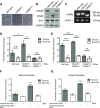CIN85 Deficiency Prevents Nephrin Endocytosis and Proteinuria in Diabetes
- PMID: 27531950
- PMCID: PMC5314701
- DOI: 10.2337/db16-0081
CIN85 Deficiency Prevents Nephrin Endocytosis and Proteinuria in Diabetes
Abstract
Diabetic nephropathy (DN) is the major cause of end-stage renal disease worldwide. Podocytes are important for glomerular filtration barrier function and maintenance of size selectivity in protein filtration in the kidney. Podocyte damage is the basis of many glomerular diseases characterized by loss of interdigitating foot processes and decreased expression of components of the slit diaphragm. Nephrin, a podocyte-specific protein, is the main component of the slit diaphragm. Loss of nephrin is observed in human and rodent models of diabetic kidney disease. The long isoform of CIN85 (RukL) is a binding partner of nephrin that mediates nephrin endocytosis via ubiquitination in podocytes. Here we demonstrate that the loss of nephrin expression and the onset of proteinuria in diabetic mice correlate with an increased accumulation of ubiquitinated proteins and expression of CIN85/RukL in podocytes. CIN85/RukL deficiency preserved nephrin surface expression on the slit diaphragm and reduced proteinuria in diabetic mice, whereas overexpression of CIN85 in zebrafish induced severe edema and disruption of the filtration barrier. Thus, CIN85/RukL is involved in endocytosis of nephrin in podocytes under diabetic conditions, causing podocyte depletion and promoting proteinuria. CIN85/RukL expression therefore shows potential to be a novel target for antiproteinuric therapy in diabetes.
© 2016 by the American Diabetes Association.
Figures






Comment in
-
CIN85: Implications for the Development of Proteinuria in Diabetic Nephropathy.Diabetes. 2016 Dec;65(12):3532-3534. doi: 10.2337/dbi16-0051. Diabetes. 2016. PMID: 27879403 No abstract available.
-
Targeting CITED2 for Angiogenesis in Obesity and Insulin Resistance.Diabetes. 2016 Dec;65(12):3535-3536. doi: 10.2337/dbi16-0052. Diabetes. 2016. PMID: 27879404 Free PMC article. No abstract available.
Similar articles
-
CIN85/RukL is a novel binding partner of nephrin and podocin and mediates slit diaphragm turnover in podocytes.J Biol Chem. 2010 Aug 13;285(33):25285-95. doi: 10.1074/jbc.M109.087239. Epub 2010 May 10. J Biol Chem. 2010. PMID: 20457601 Free PMC article.
-
Podocytic PKC-alpha is regulated in murine and human diabetes and mediates nephrin endocytosis.PLoS One. 2010 Apr 16;5(4):e10185. doi: 10.1371/journal.pone.0010185. PLoS One. 2010. PMID: 20419132 Free PMC article.
-
Semaphorin3a promotes advanced diabetic nephropathy.Diabetes. 2015 May;64(5):1743-59. doi: 10.2337/db14-0719. Epub 2014 Dec 4. Diabetes. 2015. PMID: 25475434 Free PMC article.
-
Role of nephrin in renal disease including diabetic nephropathy.Semin Nephrol. 2002 Sep;22(5):393-8. doi: 10.1053/snep.2002.34724. Semin Nephrol. 2002. PMID: 12224046 Review.
-
Podocyte endocytosis in the regulation of the glomerular filtration barrier.Am J Physiol Renal Physiol. 2015 Sep 1;309(5):F398-405. doi: 10.1152/ajprenal.00136.2015. Epub 2015 Jun 17. Am J Physiol Renal Physiol. 2015. PMID: 26084928 Free PMC article. Review.
Cited by
-
High glucose-mediated PICALM and mTORC1 modulate processing of amyloid precursor protein via endosomal abnormalities.Br J Pharmacol. 2020 Aug;177(16):3828-3847. doi: 10.1111/bph.15131. Epub 2020 Jul 14. Br J Pharmacol. 2020. PMID: 32436237 Free PMC article.
-
Zebrafish Model to Study Podocyte Function Within the Glomerular Filtration Barrier.Methods Mol Biol. 2023;2664:145-157. doi: 10.1007/978-1-0716-3179-9_11. Methods Mol Biol. 2023. PMID: 37423988
-
A human stem cell-derived model reveals pathologic extracellular matrix remodeling in diabetic podocyte injury.Matrix Biol Plus. 2024 Nov 2;24:100164. doi: 10.1016/j.mbplus.2024.100164. eCollection 2024 Dec. Matrix Biol Plus. 2024. PMID: 39582511 Free PMC article.
-
The Protective Effect of Shen Qi Wan on Adenine-Induced Podocyte Injury.Evid Based Complement Alternat Med. 2020 Nov 20;2020:5803192. doi: 10.1155/2020/5803192. eCollection 2020. Evid Based Complement Alternat Med. 2020. PMID: 33273954 Free PMC article.
-
Revisiting nephrin signaling and its specialized effects on the uniquely adaptable podocyte.Biochem J. 2025 Jun 2;482(11):763-88. doi: 10.1042/BCJ20230234. Biochem J. 2025. PMID: 40457651 Free PMC article. Review.
References
-
- Jefferson JA, Shankland SJ, Pichler RH. Proteinuria in diabetic kidney disease: a mechanistic viewpoint. Kidney Int 2008;74:22–36 - PubMed
-
- Susztak K, Raff AC, Schiffer M, Böttinger EP. Glucose-induced reactive oxygen species cause apoptosis of podocytes and podocyte depletion at the onset of diabetic nephropathy. Diabetes 2006;55:225–233 - PubMed
-
- Stieger N, Worthmann K, Teng B, et al. . Impact of high glucose and transforming growth factor-β on bioenergetic profiles in podocytes. Metabolism 2012;61:1073–1086 - PubMed
MeSH terms
Substances
Grants and funding
LinkOut - more resources
Full Text Sources
Other Literature Sources
Molecular Biology Databases

